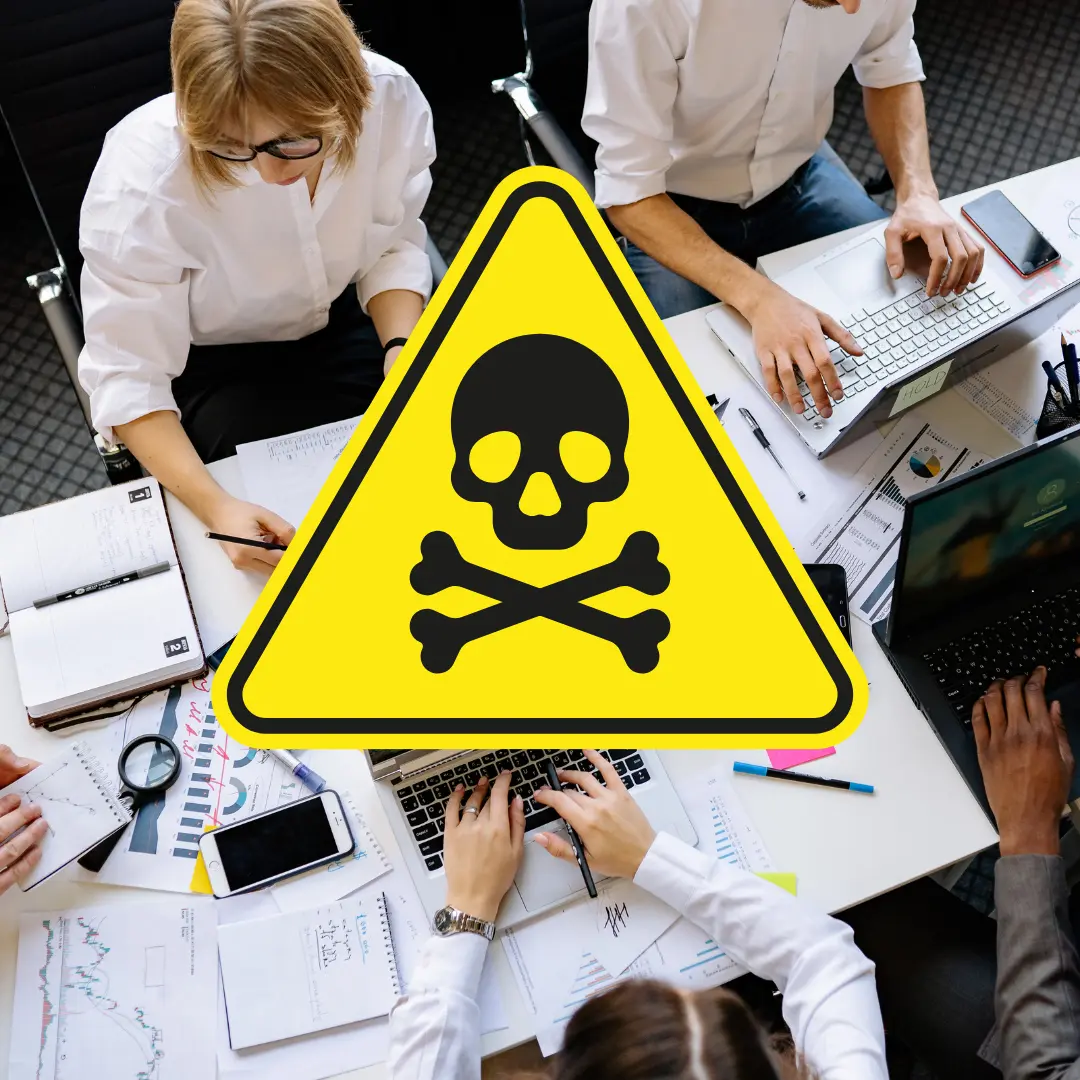A toxic work environment can affect more than just your 9-to-5—it seeps into your mental health, personal life, and even long-term career growth. Many professionals face unhealthy workplace cultures but struggle to recognize the signs or find a way out. This article explores what defines a toxic workplace, the warning signals, the causes behind it, and practical steps to cope or leave.
What Is a Toxic Work Environment?
Core characteristics of a toxic work environment include:
- Chronic Negativity: Complaints, pessimism, and criticism dominate daily interactions. Employees often leave meetings feeling demoralized rather than motivated.
- Poor Leadership: Leaders either micromanage, favor certain employees, or fail to provide guidance, creating confusion, resentment, and lack of direction.
- Lack of Trust: Employees feel constantly monitored or second-guessed, which discourages initiative and collaboration.
- Unhealthy Competition: Rivalry is encouraged over teamwork, fostering resentment instead of cooperation.
- Low Employee Morale: High stress, frequent conflicts, and limited recognition result in disengaged and demotivated staff.
- Limited Opportunities for Growth: In a toxic workplace, talent is often overlooked, and employees have few chances to learn, advance, or be rewarded fairly.
In a toxic work environment, the culture itself becomes the barrier to productivity and satisfaction. Even highly skilled and motivated employees may struggle to thrive, as the negative dynamics sap energy, creativity, and confidence.
How It Differs From a Challenging Workplace
Not every demanding job is toxic. A challenging workplace may push employees toward improvement, but a toxic one damages mental and physical well-being. The difference lies in whether the culture builds resilience or destroys morale.
Warning Signs of a Toxic Work Environment
Recognizing a toxic work environment early is crucial to protecting your well-being and career growth. Toxic workplaces often have subtle, ongoing patterns that wear employees down over time. Here are the most common warning signs:
Lack of Communication and Transparency
- Withholding Information: In toxic workplaces, critical information is often kept from employees, intentionally or otherwise. This creates confusion and prevents staff from performing effectively, leading to frustration and mistakes.
- Confusing or Mixed Messages: Managers may give conflicting instructions or change priorities without explanation. Employees feel misled, unsure about expectations, and often blame themselves for failures that are not their fault.
Bullying, Gossip, and Harassment
- Subtle vs. Direct Behaviors: Toxic behavior ranges from snide comments, sarcasm, and exclusion to overt harassment or intimidation. Even minor, repeated negative interactions can create a hostile atmosphere.
- Digital Harassment at Work: In today’s workplace, toxicity isn’t limited to in-person interactions. Harassment through emails, messaging apps, or virtual meetings can make employees feel constantly monitored and unsafe.
Unreasonable Workload and Burnout
- Overtime as a Norm: Some organizations reward employees for working extra hours, sending the message that personal life and rest are secondary. This culture encourages burnout and reduces long-term productivity.
- Unrealistic Deadlines: When deadlines are consistently impossible to meet, stress becomes chronic. Employees may work under constant pressure, sacrificing creativity and quality in their output.
Micromanagement and Lack of Trust
- Signs of Micromanagement: Leaders who monitor every minor task, demand constant updates, or refuse delegation demonstrate a lack of trust. Employees feel controlled rather than empowered.
- Effects on Productivity: Micromanagement stifles initiative and innovation. Employees may stop contributing ideas or taking risks, fearing criticism or failure, which reduces overall team performance.
High Turnover and Low Morale
- Why Employees Quit Toxic Jobs: Talented employees usually leave first when a workplace becomes unbearable. High turnover is often a direct consequence of poor leadership, favoritism, or chronic stress.
- Impact on Team Dynamics: When top performers leave, remaining staff may feel overburdened and demotivated. This creates a cycle of low morale, further resignations, and worsening workplace culture.
Common Causes of a Toxic Work Environment

Understanding the root causes of a toxic work environment can help employees recognize early warning signs and organizations prevent long-term damage to their teams. Toxicity usually stems from leadership failures, poor policies, unhealthy competition, or a lack of balance between work and life.
Poor Leadership and Management Styles
Leadership sets the tone for workplace culture. Poor management is one of the most common causes of a toxic work environment:
- Authoritarian vs. Absent Leaders: Extreme leadership styles create dysfunction. Authoritarian leaders control every decision, leaving no room for creativity or autonomy. Conversely, absent leaders fail to provide guidance or support, forcing employees to navigate challenges alone. Both extremes increase stress, frustration, and disengagement.
- Favoritism and Bias: When promotions, projects, or recognition are based on personal bias rather than merit, resentment builds. Employees feel undervalued, and morale drops. Over time, this fosters a culture of mistrust and division.
Absence of Clear Policies and Boundaries
A workplace without clear rules and defined expectations often becomes a breeding ground for toxicity:
- Undefined Roles: When job responsibilities aren’t clearly outlined, employees may step on each other’s toes or feel unsure of priorities. This confusion leads to conflicts, inefficiency, and frustration.
- No Accountability System: Without consequences for negative behaviors, toxic workers can manipulate situations, bully colleagues, or shirk responsibilities without repercussion. This lack of enforcement allows bad behavior to fester and spreads negativity across the team.
Unhealthy Competition and Favoritism
While healthy competition can motivate teams, toxic workplaces often twist competition into rivalry:
- Pitting Employees Against Each Other: Managers who encourage employees to compete instead of collaborate create tension and mistrust. Instead of working together toward shared goals, employees focus on protecting their position or undermining others.
- Toxic Reward Systems: Rewarding only short-term results without valuing teamwork or effort encourages corner-cutting, manipulation, and unethical practices. Employees become focused on winning at all costs, further damaging morale and cohesion.
Lack of Work-Life Balance
A workplace that disregards employee well-being often leads to burnout, a hallmark of a toxic work environment:
- Overworking as a Badge of Honor: Some organizations glorify employees who sacrifice personal time for work, reinforcing unhealthy behaviors. Constant overtime without recognition for results leads to exhaustion, resentment, and reduced productivity.
- Lack of Flexibility: Outdated or rigid policies ignore employees’ real needs, from flexible hours to remote work options. When staff feel trapped or unsupported in balancing work and personal life, stress escalates, creating an ongoing toxic cycle.
The Impact of a Toxic Work Environment on Employees

Working in a toxic work environment doesn’t just make your job unpleasant—it can have long-lasting effects on your mental, physical, and professional well-being. Understanding these impacts can help employees recognize the warning signs early and take steps to protect themselves.
Mental and Emotional Consequences
A toxic workplace is emotionally draining. Employees often experience:
- Stress and Anxiety: Constant tension from unrealistic deadlines, micromanagement, or workplace bullying can lead to chronic stress. This stress may manifest as irritability, difficulty concentrating, or feeling overwhelmed by even simple tasks. Over time, the anxiety can affect both work performance and personal life.
- Depression and Low Self-Esteem: Toxic environments often involve criticism, favoritism, or exclusion. Employees may begin to doubt their abilities, feel undervalued, and develop a sense of helplessness. Persistent exposure to negativity can contribute to depression, withdrawal from social interactions, and diminished self-worth.
- Emotional Exhaustion: Feeling emotionally drained at the end of the day is a hallmark of a toxic work environment. When employees must constantly navigate conflict, gossip, or a lack of support, emotional resilience erodes, leaving them disengaged and unmotivated.
Physical Health Risks
The effects of a toxic work environment are not limited to the mind—they can also manifest physically:
- Sleep Disorders: Persistent stress and anxiety can disrupt sleep patterns, causing insomnia or poor-quality sleep. Lack of rest further reduces focus and increases irritability, creating a vicious cycle.
- Chronic Fatigue and Burnout: Long hours, constant pressure, and lack of support lead to burnout. Employees may feel constantly exhausted, even after a full night’s sleep, and struggle to maintain energy for daily tasks.
- Physical Symptoms of Stress: Headaches, digestive issues, high blood pressure, and weakened immune response are common in employees exposed to toxic workplace conditions over time.
Career Growth and Professional Stagnation
A toxic work environment can also stall professional development and long-term career growth:
- Missed Opportunities: Employees in toxic workplaces may be overlooked for promotions or skill-development opportunities. Decisions may favor favoritism or politics rather than merit, leaving talented individuals stuck in the same role.
- Damaged Reputation: Even if the employee is competent, working in a toxic environment may unfairly affect their reputation. For example, if a company experiences high turnover or a poor work culture, employees may be judged by association.
- Reduced Motivation and Creativity: Constant criticism, micromanagement, or fear of making mistakes can stifle innovation. Employees may avoid taking initiative or trying new approaches, limiting both personal growth and contribution to the organization.
- Difficulty Networking and Career Transition: Emotional exhaustion and low morale can reduce confidence when seeking external opportunities. Employees may struggle to maintain professional relationships, attend networking events, or pursue career development outside their toxic workplace.
How to Cope With and Escape a Toxic Work Environment

Setting Boundaries at Work
- Communication Strategies: Be clear about limits.
- Learning to Say No: Protect your time and energy.
Seeking Support From HR or Colleagues
- When HR Helps and When It Doesn’t: Know what to expect.
- Finding Allies at Work: Support from peers can make survival easier.
Building a Support Network Outside Work
- Family and Friends as a Safety Net: Emotional support matters.
- Professional Counseling: Therapy can help process workplace stress.
Knowing When It’s Time to Leave
- Red Flags You Can’t Ignore: Constant dread, poor health, and isolation.
- Planning Your Exit Strategy: Update your resume and quietly explore opportunities.
Steps to Transition to a Healthier Workplace
- Job Hunting While Employed: Stay professional until you’re ready.
- Evaluating Company Culture: Ask questions during interviews.
- How to Explain Leaving a Toxic Job in Interviews: Stay factual, not bitter.
- Turning a Negative Experience Into Growth: Highlight resilience and lessons learned.
Final Thoughts on Overcoming a Toxic Work Environment
A toxic work environment is never worth sacrificing your health or career growth. Recognizing the warning signs, understanding the causes, and taking decisive action are the first steps toward freedom. Remember: choosing growth over negativity doesn’t just mean leaving a bad job—it means moving toward workplaces where respect, collaboration, and balance are valued.

[…] Boost My Career: How Learning a Language can Skyrocket Your Success Introduction: Why Data Privacy Matters More Than Ever Toxic Work Environment: Signs, Causes, and How to Escape It […]